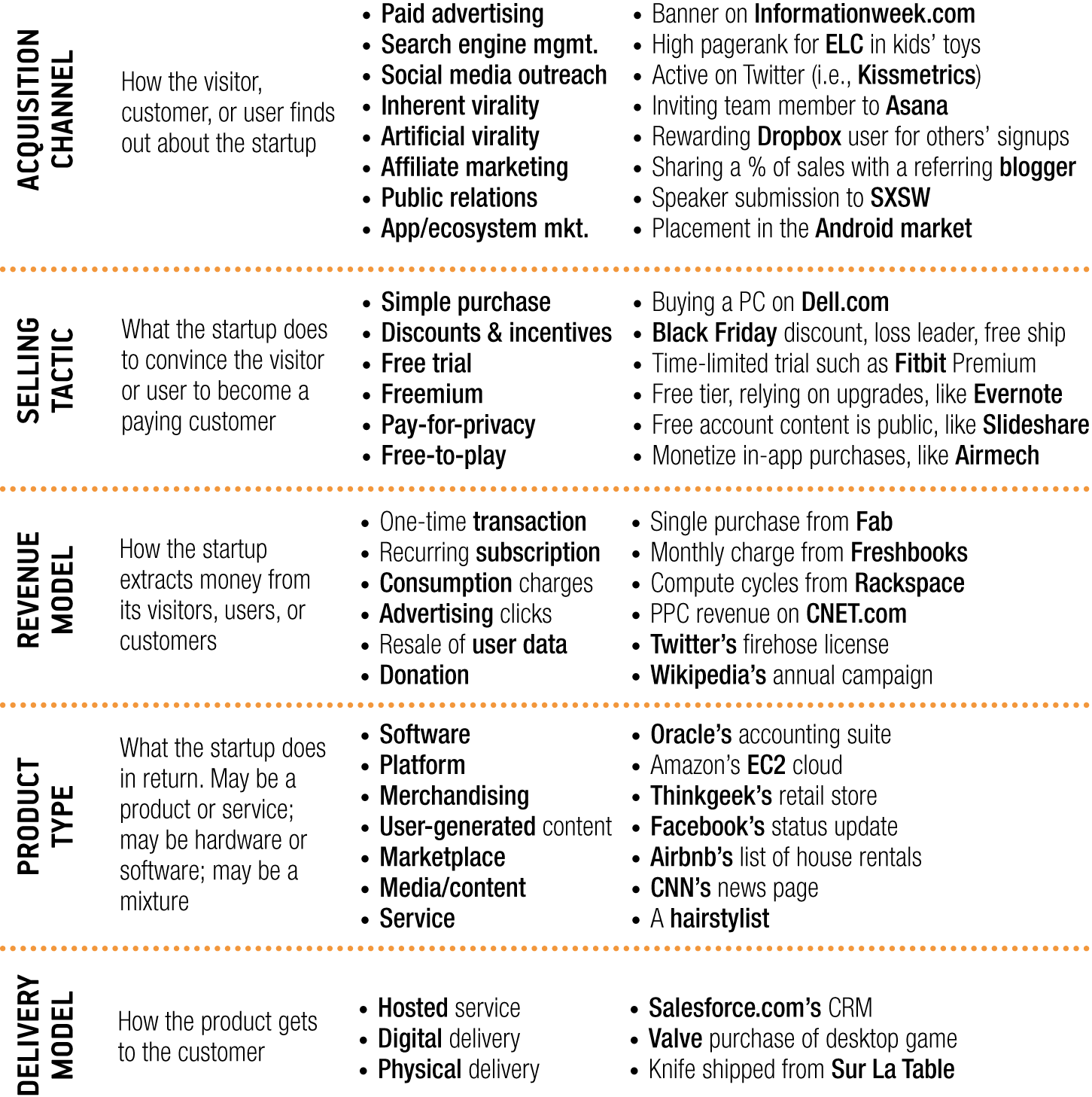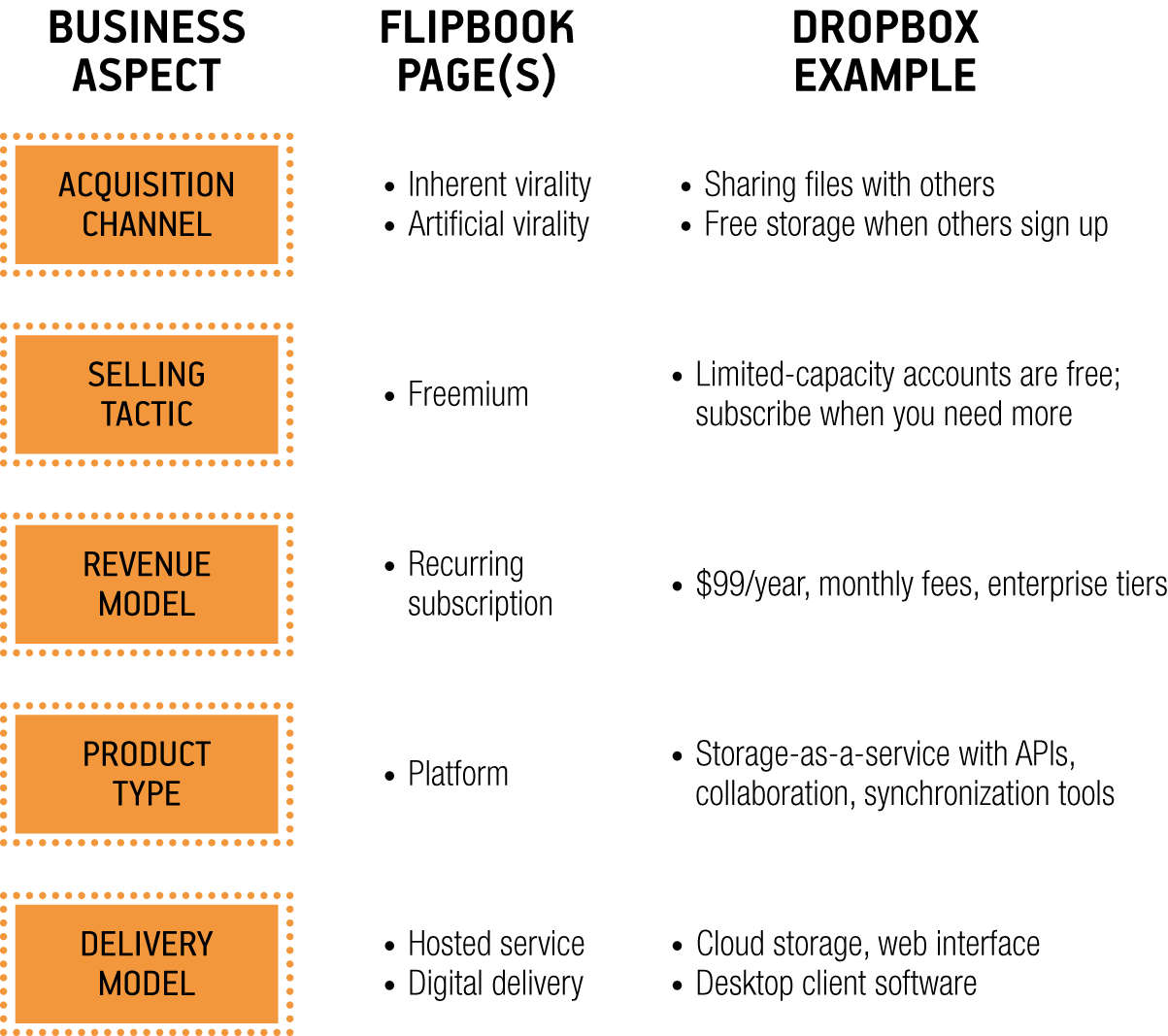Analytics are key to a strong startup business model
Learn how to create a business model that includes the right metrics and get an introduction to the Business Model Flipbook planning tool.
 Lemonade stand. (source: Pixabay)
Lemonade stand. (source: Pixabay)
How you get and make money drives what metrics you should
care about. In the long term, the riskiest part of a business is often
directly tied to how it makes money.
Many startups can build a product and solve technical issues, some
can attract the right (and occasionally large) audiences, but few make
money. Even giants like Twitter and Facebook have struggled with
extracting money from their throngs of users.
There’s no more iconic symbol of a startup than the lemonade
stand, and with good reason—it’s a simple, entrepreneurial, low-risk way
to learn how businesses operate. And like a lemonade stand, while it
might be reasonable and strategic to delay monetization—giving away
lemonade for a while to build a clientele—you have to be planning your
business model early on.
If we asked you to describe the business model of a lemonade
stand, you’d probably say that it’s about selling lemonade for more than
it costs to make it. Pressed for more detail, you might say that costs
include:
-
Variable costs of materials (lemons, sugar, cups,
water) -
One-time costs of marketing (stand, signage, cooler, bribing a
younger sibling to stand in the street) -
Hourly costs of staffing (which, let’s face it, are pretty
negligible when you’re a kid)
You might also say that revenue is a function of the price you
charge, and the number of cups sold.
Now let’s suppose that you’re asked to identify the risky
parts of the business. They include the variability of citrus futures,
the weather, the foot traffic in your neighborhood, and so on.
One thing we’ve noticed about almost all successful founders we’ve
met is their ability to work at both a very detailed, and a very
abstracted, level within their business. They can worry about the layout
of a page or the wording of an email subject one day, and consider the
impact of one-time versus monthly recurring sales the next. That’s
partly because they’re not only trying to run a business, they’re also
trying to discover the best business model.
To decide which metrics you should track, you need to be able to
describe your business model in no more complex a manner than a lemonade
stand’s. You need to step back, ignore all the details, and just think
about the really big components.
When you reduce things to their basic building blocks in this way,
you come up with only a few fundamental business models on the Web.
Interestingly, all of them share some common themes. First, their aim is
to grow (in fact, Paul Graham says that a focus on growth is the one
defining attribute of a startup).1 And second, that growth is achieved by one of Eric Ries’s
fundamental Engines of Growth: an increase in stickiness, virality, or
revenue.
Each business model needs to maximize the thrust from these three
engines in order to flourish. Sergio Zyman, Coca-Cola’s CMO, said
marketing is about selling more stuff to more people more
often for more money more efficiently.2
Business growth comes from improving one of these five
“knobs”:
-
More stuff means adding
products or services, preferably those you know your customers want
so you don’t waste time building things they won’t use or buy. For
intrapreneurs, this means applying Lean methods to new product
development, rather than starting an entirely new company. -
More people means adding
users, ideally through virality or word of mouth, but also through
paid advertising. The best way to add users is when it’s an integral
part of product use—such as Dropbox, Skype, or a project management
tool that invites outside users outsiders—since this happens automatically and implies an
endorsement from the inviting user. -
More often means stickiness
(so people come back), reduced churn (so they don’t leave), and
repeated use (so they use it more frequently). Early on, stickiness
tends to be a key knob on which to focus, because until your core
early adopters find your product superb, it’s unlikely you can
achieve good viral marketing. -
More money means upselling
and maximizing the price users will pay, or the revenue from ad
clicks, or the amount of content they create, or the number of
in-game purchases they make. -
More efficiently means
reducing the cost of delivering and supporting your service, but
also lowering the cost of customer acquisition by doing less paid
advertising and more word of mouth.
About Those People
Business models are about getting people to do what you want in
return for something. But not all people are
equal. The plain truth is that not every user is good for
you.
-
Some are good—but only in the long term. Evernote’s freemium
model works partly because users eventually sign up for paying
accounts, but it can take them two years to do so. -
Some provide, at best, free marketing, and while they may
never become paying users, they may amplify your message or invite
someone who will pay. -
Some are downright bad—they distract you, consume resources,
spam your site, or muddy your analytics.
When you get a wave of visibility, few of the resulting visitors
will actually engage with your product. Many are just driving by. As
Vinicius Vacanti, co-founder and CEO of Yipit, recalls in a blog post
inspired by his company’s 2010 launch:3
Was that our big launch? Why didn’t more people sign up? Why
didn’t people complete the sign-up flow? Why weren’t people coming
back? Now that people covered our startup, how are we supposed to
get more press? Why aren’t our users pushing their actions to
Facebook and Twitter? We got some users to invite their friends but
why aren’t their friends accepting the invite?
The key here is analytics. You need to segment real,
valuable users from drive-by, curious, or detrimental ones. Then you
need to make changes that maximize the real users and weed out the bad
ones. That may be as blunt as demanding a credit card up front—a sure
way to reject curious users who don’t have any intention of committing
or paying. Or it may be a subtler approach, such as not trying to
reactivate disengaged users once they’ve been gone for a while.
If you’re a developer of a game that users play once, or an
e-commerce site stocking rarely purchased items, that’s fine—just get
your money up front. If you’re a SaaS provider with low incremental
costs for additional users, freemium may work, as long as you clearly
separate engaged from casual users. If you expect buyers to purchase
from you often, you need to make them feel loved. You get the
picture.
Segmenting real users from casual ones also depends on how much
effort your users have to put into using the application. Some
products collect information passively: Fitbit logs walking steps;
Siri notices when you’ve arrived somewhere; Writethatname analyzes
your inbox for new contacts. Users don’t have to do much, so it can be
hard to tell if they’ve “checked out.” It’s easier to find disengaged
users if they have to actively use the product.
Consider the aforementioned Fitbit, a tiny life-logging device
that measures steps, from which it calculates calories burned, miles
walked, stairs climbed, and overall activity.
Fitbit users can simply record their steps with a device in
their pocket, they can use it to sync data to the company’s hosted
application, they can visit the portal to see their statistics and
share them with friends, they can manually enter sleep and food data
to augment what’s collected passively, and they can buy the premium
Fitbit offering to help them reach their health goals.
Each of these use models represents a different tier of
engagement, and Fitbit could segment users across these five segments.
And it should: it’s perfectly acceptable for a Fitbit user to only use
the clip-on device to record the number of steps taken per day,
without ever uploading that information, but as a result the company
won’t be able to monetize that user beyond the initial purchase
(through on-site ads, premium subscriptions, or selling aggregate user
data, for example). The value of that user is significantly lower.
Predicting revenues accurately relies on an understanding of how its
different user segments employ the product.
As a startup, you have a wide range of payment and incentive
models from which to choose: freemium, free trial, pay up-front,
discount, ad-funded, and so on. Your choice needs to match the kind of
segmentation you’re doing, the time it takes for a user to become a
paying customer, how easy it is to use your service, and how costly an additional
drive-by user is to the business.
Not all customers are good. Don’t fall victim to customer
counting. Instead, optimize for good customers
and segment your activities based on the kinds of customer those
activities attract.
The Business Model Flipbook
A product is more than the thing you buy. It’s the mix of
service, branding, fame, street cred, support, packaging, and myriad
other factors you pay for. When you purchase an iPhone, you’re also
getting a tiny piece of Steve Jobs’s persona.
In the same way, a business model is a combination of things.
It’s what you sell, how you deliver it, how you acquire customers, and
how you make money from them.
Many people blur these dimensions of a business model. We’re
guilty of it, too. Freemium isn’t a business model—it’s a marketing
tactic. SaaS isn’t a business model—it’s a way of delivering software.
The ads on a media site aren’t a business model—they’re a way of
collecting revenue.
Later in the book we’re going to outline six sample businesses.
But before we do that, we want to talk about how we came up with them.
Think of one of the flipbooks you had as a kid—the kind where you
could combine different body parts on each page to make different
characters.
You can build business models this way, but instead of heads,
torsos, and feet, you have several aspects of a business: the
acquisition channel, selling tactic, revenue source, product type, and
delivery model.
-
The acquisition channel
is how people find out about you. -
The selling tactic is how
you convince visitors to become users or users to become
customers. Generally, you either ask for money or you provide some
kind of scarcity or exclusivity—such as a time limit, a capacity
limit, the removal of ads, additional functionality, or the desire
to keep things to themselves—to convince them to act. -
The revenue source is
simply how you make money. Money can come from your customers
directly (through a payment) or indirectly (through advertising,
referrals, analysis of their behavior, content creation, and so
on). It can include transactions, subscriptions, consumption-based
billing charges, ad revenue, resale of data, donations, and much
more. -
The product type is what
value your business offers in return for the revenue. -
The delivery
model is how you get your product to the
customer.
Figure 1-1
shows these five aspects, with a variety of models and examples for
each one. Remember that this is only a set of examples—most businesses
will rely on several acquisition channels, or experiment with
different revenue models, or try various sales tactics.

words
Lots to Choose From
There is an abundance of “pages” you can put into the
flipbook. The team at Startup Compass, a startup dedicated to
helping companies make better business decisions with data,
identifies 12 revenue models: advertising, consulting, data, lead
generation, licensing fee, listing fee, ownership/hardware, rental,
sponsorship, subscription, transaction fee, and virtual goods.
Venture capitalist Fred Wilson has a document listing a vast number
of web and mobile revenue models, many of which are
variants on six basic ones we’ll list later in the book.4
Startup Compass also suggests some “fundamental” financial
models that combine several pages from the flipbook: search, gaming,
social network, new media, marketplace, video, commerce, rental,
subscription, audio, lead generation, hardware, and payments.
You can use these “pages” to create a back-of-the-napkin
business model. For example, Figure 1-2 shows a sample
business model flipbook for Dropbox.

There’s another advantage of stating business models in a
flipbook structure like this: it encourages lateral thinking. Each
turn of a “page” is a pivot: what would it mean to offer Dropbox as
a physical delivery? Or to charge up front for it? Or to rely on
paid advertising?
Six Business Models
In the coming chapters, we’re going to look at six business
models. Each model is a blend of these aspects, and we’ve tried to mix
them up enough to give you a taste of some common examples. But just
like a kid’s flipbook, there’s a huge variety: from the aforementioned
list, there are over 6,000 permutations, and our list of aspects isn’t
by any means exhaustive.
As if that weren’t confusing enough, you can employ
several at once: Amazon is a transactional, physical-delivery, SEM
(search engine marketing), simple-purchase retailer, but it’s also
running sub-businesses such as user-generated content in the form of
product reviews. So unlike those relatively simple children’s books,
your business can quite easily be a many-headed monster.
In the face of this complexity, we’ve decided to keep our six
business models simple. We’ll talk about several aspects of those
businesses, and the metrics that matter most to companies of each
sort. Think of it as opening the business model flipbook to a
particular “page”—one in which you see elements of your own
business.
-
If you’re running an e-commerce business where you sell
things to customers, turn to not available. -
If you’re delivering SaaS to users, turn to not available.
-
If you’re building a mobile application and using in-app
purchases to generate revenue, head to not available. -
If you’re creating content and making money from
advertising, you’ll find details on media sites in not available. -
If your primary focus is getting your users to generate
content on your platform the way Twitter, Facebook, or reddit do,
turn to not available. -
If you’re building a two-sided marketplace where buyers and
sellers can come together, check out not available.
Most businesses fall into one of these categories. Some won’t,
but they have close parallels in the real world. A restaurant is
transactional, like e-commerce; an accounting business offers a
recurring service, like a SaaS company, and so on. Hopefully, you’ll
find a model that’s close enough for you to learn important lessons
about analytics and apply them to your business, as we review the
stages of growth in not available and beyond.
Pick Your Business Model
In the following chapters we go through six sample business
models. Find yours and write it down, then list all the metrics we
define in that business model and see how well that aligns with what
you’re tracking. For the metrics that you’re tracking, put down the
values as they stand today, if you haven’t already. If your business
overlaps on a couple of models (which isn’t uncommon), then grab
metrics from each of those models and include them in this
exercise.
